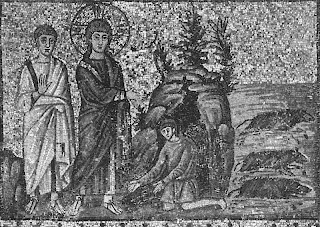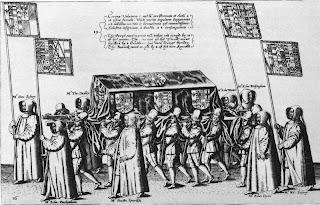 |
| Image from Wikipedia |
The only method given in the 3 LBBs for acquiring new spells is magical research. No mention is made of copying scrolls into spell books, as is common in many later editions. The magical research system (detailed on Men & Magic page 34) is based on GP investment followed by a percentile roll for success. Costs per 20% chance are, by level of spell:
- 2000 GP
- 4000 GP
- 8000 GP
- 16000 GP
- 32000 GP
- 64000 GP
There are no spells above sixth level that can be prepared in spell slots (though there may exist more powerful ritual magic). The expense is cumulative, so that if you spend 10000 GP on researching a first level spell, there is a 100% chance of success. One week per spell level is required per attempt.
This is quite expensive, but in my game there are some house rules for increasing the chances of success without investing more GP. Here are some such ways (a few are based on ideas described in more detail in Spells by Reverse Engineering & Dissection). The epiphenomena of researched spells will likely be affected by the type of research employed.
- Reverse Engineering
- If you are willing to destroy a magic item in pursuit of magical insight, that is worth a 20% bonus to the spell research roll. The item must be relevant to the spell effect in some way. Note that this covers using scrolls in magical research rather than casting the spell from them directly.
- Dissection
- If you can procure (by capture or purchase) a magical creature that is related in some way to the spell being researched, that is worth a 20% bonus to the spell research roll. For example, a creature that can use shadows as portals might be useful for researching dimension door. Mundane creatures are not generally useful for this bonus (thus, dissecting birds does not help with researching fly).
- Studying Another Magic-User’s Spell Book
- You can’t just copy a spell, but if you have access to another magic-user’s version of a spell, that is worth a 20% bonus to the spell research roll. Access to a grimoire works also.
- Human Sacrifice
- Magic-users with flexible morals may consume sentient, intelligent lives to help power their dark investigations. The number of souls required for a 20% bonus to the research roll is equal to the GP value of investment by spell level divided by 1000. Thus, a first level spell requires 2 while a sixth level spell requires 64. Not all spells can benefit from human sacrifice.
- Places of Power
- Some locations are inherently magical, either due to the echoes of past events, or strange connections to other places and times. Some examples are ancient standing stones and sites that exist half in the mortal realm and half in Dream-Land. Performing research for some kinds of spells in certain places is worth a 20% bonus on the research roll.
- Self Sacrifice
- Some magic-users crave power so much that they are willing to give of themselves. You may spend 1d4 ability score points or one hit die for a 20% bonus to a spell research roll. These reductions are permanent. Spells researched through self-sacrifice are said to be more deeply tied to their creator than other spells.
- Assistance
- What are apprentices good for, if they can’t help you with magical research? An arcane entourage will provide a 20% bonus to spell research rolls. One apprentice per spell level is required for this bonus (so six assistants are required to get any benefit during the research of a sixth level spell). The assistants in question must be skilled enough to prepare spells of levels two beneath the level of the spell being researched.
- Mind invasion
- ESP along with a subdued magic-user that has a given spell prepared is much the same as having access to a spell book with the magic formula. Not for the squeamish or ethical.
- Specialized Library
- Large collections of specialized books are quite rare and valuable, but may in some cases be worth a 20% research bonus.
- Diabolism
- Demons know a lot about magic. If you give a demon or spirit something, it might help you out enough to get a 20% research roll bonus.
 |
| Image from Wikipedia |
Each attempt must include at least one unit of monetary investment (for example, at least 16000 GP must be spent on any attempt to research a fourth level spell). In general, other forms of assistance may be used no more than once per attempt. For example, a magic-user could capture and dissect a salamander during the research for wall of fire, but capturing and dissecting another fire-oriented creature would not grant another 20% bonus for this particular spell.
Abstract magical research may be performed at any point, if the GP is available. This may be applied to any future specific attempt, but abstract magical research functions like carousing and requires a saving throw versus spells to avoid unintended (but often amusing) consequences.
- What happens if the roll fails?
- The preparation and investment are not totally lost, but some aspect of the magic-user’s understanding or ritual preparation was off. One of the 20% bonuses is wasted. So, if you only invested the minimum needed GP and didn’t use any other form of assistance, you must start over from scratch. The magic-user may try again in one moon with the reduced percentage (if any is left over), or invest further in the procedure. The same preparation may not be used for a different spell.
- What about researching a spell in the rules versus making up your own spell?
- Mechanically, these two cases are handled the same way. However, it will generally be easier to find non-monetary components to assist with the research of spells from the rules, as scrolls and NPC spell books will contain formula for those spells. Also, I have seeded the campaign world with other features and items that are useful for researching particular spells.
- How does this interact with the grimoire system?
- If you have a grimoire, and cast read magic to interpret a spell in it (only needed before preparing the spell for the first time), you may prepare the spell as normal. However, the spell is not “yours” and if you lose the grimoire in question, you will not be able to prepare the spell again. Researching a spell (either one from the book, or a new one from your imagination) does not allow you to create a grimoire, which is a special kind of magic item. Creating a true grimoire is the feat of a great archmage. Thus, finding a grimoire is the least expensive way to get access to a new spell that is not consumed after one use (as a scroll is so consumed).
- How does this apply to clerics?
- Clerics use the same system for magical research, but the list of potential aids is different, and will likely be covered in a future post. Cleric magic is more limited than the sorcery of magic-users; methods of discovering new cleric spells generally include activities like copying holy scripture and staging secret rites.
 |
| Image from Wikipedia |
There are stories about guilds of magic-users that share spell books, thereby easing the cost of magical research (one only needs time with another magic-user’s spell book to use it as an aid in magical research). No such actual organizations near Pahvelorn are known, however, and magic-users tend to be a jealous, paranoid, secretive lot. Also, legend has it that learning another magic-user’s spells will give you insight into the weaknesses of those spells and potentially even power over their creator, much like knowing a true name.





